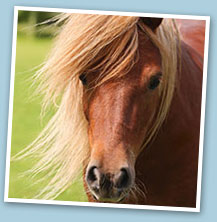
Spring into action – gently!
Horses' fitness levels tend to dwindle during winter – and the same is true of their riders! Copious amounts of mud, limited daylight and lack of competition mean there is little incentive or opportunity to keep up a strict regime. However, now spring beckons – and with it the hope of better weather and some exciting events – it's worth ensuring your horse is in tip top shape for the coming months.
Whether you roughed him off for the season or simply gave him a quieter few months, stepping up his fitness levels should be done gradually and thoroughly.
Top-class three-day eventer Blyth Tait has some top tips worth heeding:
- Ensure your horse is sufficiently fit for the level of competition intended.
- Increase workload gradually.
- Don't be too rigid in your preconceived plans for your fitness programme.
- Vary the type of work.
How fit should my horse be?
A Badminton-bound horse needs a dramatically different fitness regime from a riding clubber competing at unaffiliated level. It isn't necessary for the latter to be racing-fit, because a horse at his physical limits is more likely to put extra wear and tear on his limbs. However, there are still basic principles in common.
Let's take a horse that will be competing at open riding club horse trials. Virtually any consistent exercise of 1-1½ hours per day, six days a week, incorporating dressage, jumping and cross-country schooling, will get him sufficiently fit for this level. But if your horse is currently roughed off, you need to build up from nothing. And those early weeks are the same for all horses, Olympic or unaffiliated. You need to be careful to prevent injury and slowly re-condition the heart and lungs.
Increase workload gradually (and feed accordingly)
For the completely unfit horse, expect to spend four weeks walking and slow trotting – from 45 minutes to 1½ hours by week four. If you have access to a horse walker, this is a good substitute when the ground is too frozen or boggy for hacking.
By week five, include some light schooling and increase the length of hacking to up to two hours. Light gridwork and canterwork can also be introduced. Over the next three weeks, gradually increase the length of cantering and intensity of gridwork. He should be ready for a cross-country schooling session by week eight, and a show jumping competition. By the end of the 10th week, he should be fit enough to do himself justice at a riding club horse trials.
Nowadays, many horses are not let down completely over the winter, meaning that riders can step in at week five and gradually increase fitness levels from there. It's about sensibly assessing your own horse and his fitness levels, and planning appropriately.
Don't stick to the plan at any cost
If a horse shows any sign of injury, back off until it has improved or wait for a veterinary diagnosis before pushing on with your schedule. Better to delay your first competition for a fortnight than exacerbate a problem.
Amateur event rider Sophie Rubie's horse Bizzy was kicked in the field last February, six weeks after starting a fitness regime. Although Bizzy was never lame, Sophie regrets pressing on regardless. "I badly wanted to stick to my schedule and had cross-country schooling booked with a good instructor, so I went," she says. "But Bizzy just wasn't herself for a month, so clearly something was hurting. By ignoring the signs, I had to wait an extra month before competing."
What sort of work?
Even in the walking phase, don't lob along on a loose rein. Make him stride out and on the bit – it will help develop his topline. Variety will keep your horse fresh and interested in his job. After the initial walking phase, it's helpful to do different exercise each day, ensuring that all his muscles are being worked.
Hills are particularly useful for increasing fitness as the horse's heart and lungs have to work harder without putting extra strain on the limbs. However, don't do much hill work in the early weeks before he is ready. And try to work on level surfaces with some give, to reduce the risk of injury. Roadwork is actually quite useful in the early phase of fitness as it helps harden up the legs.





